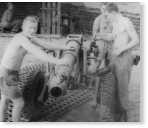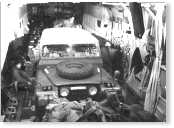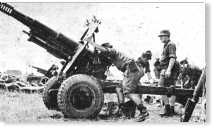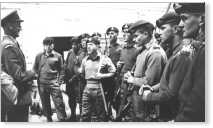|
Peter 'Doggo' Downs is compiling an oral history of the RNZEME in Vietnam as post-graduate work at Queensland University. This article explains his motivation. As a gun tiffy his career has been intimately linked with the equipments and gunners of the RNZA. Click on Peter's images to enlarge them.
 I spent 10 of my 20 years career with the gunners, 1959-1969 in 16 Field LAD. I even spent a few years before that in 12th HAA Workshops at Fort Cautley, and at ND Workshops Section, at North Head. We tackled the 9 inch guns at Waiheke, the 6 inchers on Motutapu, and of course the 40mm Bofors, and the 3.7 HAA guns. Later a posting popped me into ND Workshops at Papakura, later 1 Infantry Workshops. The posting took me right into a major modification program on the 25 pounders of 161 Battery. I spent 10 of my 20 years career with the gunners, 1959-1969 in 16 Field LAD. I even spent a few years before that in 12th HAA Workshops at Fort Cautley, and at ND Workshops Section, at North Head. We tackled the 9 inch guns at Waiheke, the 6 inchers on Motutapu, and of course the 40mm Bofors, and the 3.7 HAA guns. Later a posting popped me into ND Workshops at Papakura, later 1 Infantry Workshops. The posting took me right into a major modification program on the 25 pounders of 161 Battery.
It was a major task comprising 71 modifications. Suddenly there was a whisper a new gun was to replace the 25 pounder. Conceived in Italy, of the 105 mm family given birth to, one arrived at Papakura Camp, delivered in the door of the Armament and General Section. The two doctors (Tiffies) present at the birth were myself 'Doggo' and Sergeant Allan David Cairnswhite. There were no Electrical and Mechanical and Regulations (EMERS) available only a gun hand book. It told us nothing we needed the technical matters. Not to be stumped, Allan and I pressed on learning to strip the gun, delving into the recoil system, understanding that for example were all part of problems to perused and solved.
 We got it sorted out and even took the gun with us to the Army recruiting booth at the Auckland Easter Show. Later in 1965 I would be among the first to fight. Myself and Sergeant Rex Peebles, joined the rest of the battery departing at night under the cover of darkness instructed to be quiet, the flaps down on our RL Bedfords. We left without any farewells from our wives, girlfriends, children or relatives. And we arrived in Vietnam, immediately to be struck with culture shock. It was there in everything we saw, smelled or touched.
We got it sorted out and even took the gun with us to the Army recruiting booth at the Auckland Easter Show. Later in 1965 I would be among the first to fight. Myself and Sergeant Rex Peebles, joined the rest of the battery departing at night under the cover of darkness instructed to be quiet, the flaps down on our RL Bedfords. We left without any farewells from our wives, girlfriends, children or relatives. And we arrived in Vietnam, immediately to be struck with culture shock. It was there in everything we saw, smelled or touched.
There is not too much written about the battery at Bien Hoa, the focus has tended to be on Nui Dat, The Horseshoe, or perhaps even Fire base Coral.
 The Battery in 1965 cut into virgin territory that even the French and Japanese would not go into, the Ho Bo Woods, War Zone C, the Iron Triangle, how frightening it was to go into these places, often we were our own front line, such as one night at Tan Yuen. We had many battles during 1965-1966, Operation Rolling Stone was one such event. There are many stories to be written about the fire support bases occupied from 1965 to the Battery's withdrawal. The Battery in 1965 cut into virgin territory that even the French and Japanese would not go into, the Ho Bo Woods, War Zone C, the Iron Triangle, how frightening it was to go into these places, often we were our own front line, such as one night at Tan Yuen. We had many battles during 1965-1966, Operation Rolling Stone was one such event. There are many stories to be written about the fire support bases occupied from 1965 to the Battery's withdrawal.
The book 1965 - With The New Zealand Gunners in Vietnam: Downs, P. (1995) Porky's Publishing House NSW is an account of that 1965-66 period. A personal account, taken from diaries it portrays the situation of men, machinery and the will to fight. A dearth of information exists on our involvement in Vietnam, that is why the thesis called 'Vietnam and Bluebell' an oral history is being written.
 There are few books about Royal New Zealand Electrical and Mechanical engineers at war, let alone one told from the soldiers perspective about the war in South Vietnam. Kiwi soldiers' humour is priceless and it's wonderful to be around at any time; the way soldiers use it as a "pick-me-up" for dangerous, boring, or futile situations is a great credit to their psyche. It keeps them going, through thick and thin, and is an essential ingredient of their "mateship".
There are few books about Royal New Zealand Electrical and Mechanical engineers at war, let alone one told from the soldiers perspective about the war in South Vietnam. Kiwi soldiers' humour is priceless and it's wonderful to be around at any time; the way soldiers use it as a "pick-me-up" for dangerous, boring, or futile situations is a great credit to their psyche. It keeps them going, through thick and thin, and is an essential ingredient of their "mateship".
The Guns are always there. The gunners have no battle honours. The reason is their motto �UBIQUE' - everywhere - the symbol of the Artillery's service wherever there is fighting. UBIQUE too is the RNZEME warrior-tradesman.
In the annals of New Zealand military history particularly the period 1964-1972 of the Vietnam war, the historiography of the Corps of the Royal New Zealand Electrical and Mechanical Engineers is meagre. This is especially evident in the oral history surrounding RNZEME personnel serving in Vietnam and becomes increasingly impoverished when the history of inspection and repair is considered in the New Zealand Army at war in Vietnam.
 A full account of the involvement of RNZEME personnel in the Vietnam War is not available, such an issue is becoming more important. Military personnel who took part are now part of an aging population. Having a historical account of the involvement of the warrior-tradesmen in the Vietnam War is important for the Royal New Zealand Electrical and Mechanical Engineers Corps, the New Zealand Army and the New Zealand Community. Consequently, this thesis will investigate an overlooked but nevertheless a significant chapter in the annals of military history and thereby make a contribution to the historiography of the New Zealand Army.
A full account of the involvement of RNZEME personnel in the Vietnam War is not available, such an issue is becoming more important. Military personnel who took part are now part of an aging population. Having a historical account of the involvement of the warrior-tradesmen in the Vietnam War is important for the Royal New Zealand Electrical and Mechanical Engineers Corps, the New Zealand Army and the New Zealand Community. Consequently, this thesis will investigate an overlooked but nevertheless a significant chapter in the annals of military history and thereby make a contribution to the historiography of the New Zealand Army.
 For me, telling the story of EME in Vietnam between June 1965 and April 1972 is the least I could do for them, my comrades and my colleagues. They were young, crazy, reckless, foolhardy, brave, cheeky, cunning fighters that gave all that was needed and then some more.
For me, telling the story of EME in Vietnam between June 1965 and April 1972 is the least I could do for them, my comrades and my colleagues. They were young, crazy, reckless, foolhardy, brave, cheeky, cunning fighters that gave all that was needed and then some more.
They pioneered the way EME would operate throughout that dirty, futile war. It's a true story full of mischief it will make you laugh and make you cry and make you hold your breath.
Peter 'Doggo' Downs, June 2001
| 






